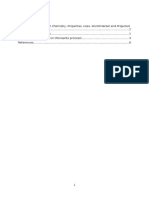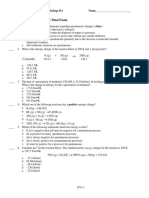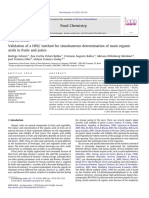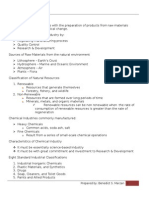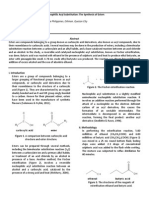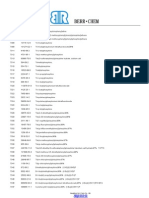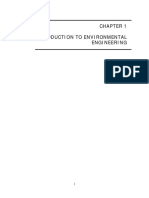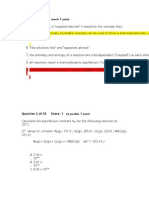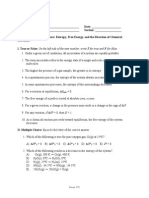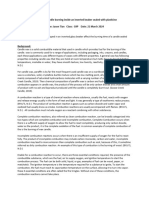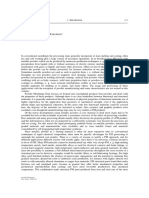Professional Documents
Culture Documents
Gen Chem II Exam 1 Ans Key VA f08
Gen Chem II Exam 1 Ans Key VA f08
Uploaded by
ASaad117Original Description:
Copyright
Available Formats
Share this document
Did you find this document useful?
Is this content inappropriate?
Report this DocumentCopyright:
Available Formats
Gen Chem II Exam 1 Ans Key VA f08
Gen Chem II Exam 1 Ans Key VA f08
Uploaded by
ASaad117Copyright:
Available Formats
1A
General Chemistry II Exam 1 (175 points) (Answer Key)
Name_______________________________________________
Multiple Choice (10 points each)
Identify the letter of the choice that best completes the statement or answers the question.
__E__ 1. For a certain process at 27C, G = +210.6 kJ and H = -168.2 kJ. What is the entropy change for this process at this
temperature? Express your answer in the form, S = __________ J/K.
a. +628.3 J/K d. 1.26 x 10
3
J/K
b. -141.3 J/K e. -1.26 x 10
3
J/K
c. +141.3 J/K
Answer:
3 3
27 273 300
( 168.2 ) ( 210.6 ) 1.26
300
1.26 10 1.26 10
o
G H T S T C K
H G kJ kJ kJ
S
T K K
kJ J J
K kJ K
= = + =
+
= = =
| | | |
=
| |
\ .
\ .
_A___ 2. Which response includes all of the following substances that have H
o
f
= 0, and no other substances?
I. HCl(g)
II. Na(s)
III. HCl(aq)
IV. F
2
(g)
a. II and IV d. I, II, III, and IV
b. II e. I, II, and IV
c. I and II
Answer: All elements in their natural standard state have a H
o
f
= 0.
__A__ 3. From the following data at 25C,
2 NOCl(g) 2 NO(g) +Cl
2
g) H
0
= +75.56 kJ
2 NO(g) + O
2
(g) 2 NO
2
g) H
0
= 113.05 kJ
2 NO
2
(g) N
2
O
4
(g)
H
0
= 58.03 kJ
Calculate H
0
at 25C for the reaction below.
N
2
O
4
(g) + Cl
2
(g) 2 NOCl(g) + O
2
(g)
a. +95.52 kJ d. 85.52 kJ
b. +299 kJ e. 246.65 kJ
c. 186.8 kJ
Answer: Reverse all reactions and change the sign of the H
0
for each.
2 NO(g) +Cl
2
(g) 2 NOCl(g) H
0
= 75.56 kJ
2 NO
2
(g) 2 NO(g) + O
2
(g) H
0
= +113.05 kJ
N
2
O
4
(g) 2 NO
2
(g) H
0
= +58.03 kJ
N
2
O
4
(g) + Cl
2
(g) 2 NOCl(g) + O
2
(g) H
0
= +95.52 kJ
2A
__A__ 4. Assuming the gases are ideal, calculate the amount of work done, in joules, for the conversion of 1.00 mole of Ni to
Ni(CO)
4
at 75C in the reaction below. The value of R is 8.314 J/molK.
Ni(s) + 4CO(g) Ni(CO)
4
(g)
a. 8.68 10
3
J d. 1.80 10
3
J
b. -1.80 10
3
J e. - 494 J
c. -8.68 10
3
J
( )
( ) ( )
4
3
Answer: Ni(s) + 4CO(g) Ni(CO) (g)
4 mol gas 1 mol gas
1 mol gas 4 mol gas 3 mol gas
8.314
75 273 348
8.314
3 mol gas 348
8.68 10
o
n
J
R
mol K
T C K
w nRT
J
K
mol K
J
= =
=
= + =
=
( | |
=
( |
\ .
= +
_B___ 5. Which of the following techniques cannot be used to calculate H
rxn
?
a. Using of Heats of Formation of reactants and products
b. Using melting points of reactants and products
c. Hess's Law
d. Using bond energies of reactants and products
e. Calorimetry
__C__ 6. Consider the reaction below at 25C for which S
0
= 16.1 J/K.
CH
4
(g) + N
2
(g) + 163.8 kJ HCN(g) + NH
3
(g)
+H
Which one of the following statements describes the reaction?
a. Insufficient information to estimate temperature range of spontaneity
b. Spontaneous at relatively low temperatures only
c. Spontaneous at relatively high temperatures only
d. Spontaneous at all temperatures
e. Nonspontaneous at all temperatures
Answer: Under conditions of positive enthalpy and positive entropy, the temperature must be
relatively high to achieve a negative free energy.
:
( ) ( )
answer G H T S =
+ +
3A
__A__ 7. At 25C H = 128.9 kJ and G = 33.5 kJ for a reaction. Above what minimum temperature will this reaction become
spontaneous?
a. 403 K d. 332 K
b. 530 K e. 298 K
c. 1150 K
( )
: .
1) .
128.9 33.5
0.320
298
Answer This is a two part answer
Determine S
G H T S
kJ
H G kJ
mol
S
T K mol K
= = =
2) 0.
128.9
403
0.320
Determine T by letting G
G H T S
H kJ
T K
kJ
S
mol K
=
=
= = =
____ 8. Which one of the following thermodynamic quantities is not a state function?
a. work d. internal energy
b. free energy e. enthalpy
c. entropy
__B__ 9. Which response includes all the following processes that are accompanied by an increase in entropy, and only those
processes?
I. boiling water l g (+S)
II.
freezing water l s ( S)
III.
N
2
(g) + 3H
2
(g) 2NH
3
(g) 4 mol gas 2 mol gas ( S)
IV. Br
2
(l) Br
2
(g) (+S)
a. I and II d. II, III, and IV
b. I and IV e. III and IV
c. another one or another combination
_B___ 10. Estimate the enthalpy change for the reaction below from the average bond energies given. There are two Cl-Cl and two
C-H bonds in CH
2
Cl
2
. Remember that energy is absorbed when bonds are broken and released when they are formed.
CH
4
(g) + 2Cl
2
(g) CH
2
Cl
2
(g) + 2HCl(g)
Average Bond Energies
C-H 413 kJ/mol Cl-Cl 242 kJ/mol
H-Cl 432 kJ/mol C-Cl 339 kJ/mol
a. +578 kJ/mol d. -578 kJ/mol
b. -232 kJ/mol e. +541 kJ/mol
c. +232 kJ/mol
( )
( )
( )
( )
( )
( ) ( )
( )
:
4 4(413 ) 1652
2 2(242 ) 484
2136
2 2(413 ) 826
2 2(339 ) 678
2 2(432 ) 864
2368
.
2136 23
Answer
reactants
C H bonds kJ kJ
Cl Cl bonds kJ kJ
kJ
products
C H bonds kJ kJ
C Cl bonds kJ kJ
H Cl bonds kJ kJ
kJ
B E reactants products
kJ
= =
+ = =
=
= =
+ = =
+ = =
=
=
=
( ) 68 232 kJ kJ =
4A
_D___ 11. How much heat is given off in the formation of 35.0 grams of Fe
2
O
3
(s) at 25C and 1.00 atm pressure by the following
reaction? The molar mass of iron(III) oxide is 159.7 g/mol.
4Fe(s) + 3O
2
(g) 2Fe
2
O
3
(s)
H (kJ/mol)
-824.2
a. 243. 9 kJ d. 180.7 kJ
b. 90.4 kJ e. 360.1 kJ
c. 151 kJ
Answer:
| | | |
2 3 2 3
2 3 2 3
( ) ( )
2( 824.2 ) 0 0
1648
35.0 1 1 1648
180.6
159.7 2 1
o
rxn
H n products n reactants
kJ
kJ
g Fe O mol Fe O mol rxn kJ
kJ
g Fe O mol Fe O mol rxn
=
= +
=
| || || |
| |
=
| | | |
\ .
\ . \ .\ .
_A___ 12. Which one of the following statements is not correct?
a. When H for a reaction is negative, the reaction is never spontaneous.
b. When G for a reaction is negative, the reaction is spontaneous.
c. When G for a reaction is positive, the reaction is nonspontaneous.
d. When G for a reaction is zero, the system is at equilibrium.
Answer: Most reactions exothermic, and as a result, the change in entropy is positive. A negative
change in enthalpy and positive change in entropy will result in a negative free energy and a
spontaneous reaction.
_E___ 13. Which statement concerning sign conventions for E = q + w is false?
a. For heat absorbed by the system, q is positive.
b. For an expansion, w is negative.
c. When energy is released by the reacting system, E is negative.
d. For work done by the system, w is negative.
e. If E is positive, energy can be written as a product in the equation for the reaction.
Answer: If the change in internal energy of a system is positive, then the system gained energy and
or had work done on it by the surroundings. In terms of a chemical reaction, this means the
reactants added heat or had work done on it (such as gases going to liquids) during the reaction
process.
5A
Problem You must show your work for the following questions and it must logically lead to your answer to receive full
credit for a question. The calculations and answers should be shown with the correct units and significant figures.
14. (45 total points) A 1.000 g sample of ethanol, C
2
H
5
OH, was burned in a bomb calorimeter whose heat capacity had been
determined to be 2.71 kJ/
o
C. The temperature of 3.000 x 10
3
grams of water rose from 24.284
o
C to 26.225
o
C. The
molar mass of ethanol is 46.07 g/mol.
a) (20 points) Determine the H for the reaction in joules per gram of ethanol.
b) (10 points) Determine the H for the reaction in kilojoules per mole of ethanol.
c) (10 points) What is the E for the reaction at constant pressure?
d) (5 points) Is work done by or on the system?
C
2
H
5
OH (l) + 3 O
2
(g) 2 CO
2
(g) + 3 H
2
O (l)
Answer:
( )
( ) ( ) ( )
3
3
3 4
4
2.71 10
) ; ; 26.255 24.284 1.941
4.184 2.71 10
3.000 10 1.941 1.941 2.96 10
2.96 10
( , )
o o
o
o o
o o
J
a q mC T calorimeter constant T C C
C
J J
q g C C J
g C C
q H
J
H remember the rxn is exothermic
g EtOH
b
= = = =
( ( | | | |
= + =
( ( | |
\ . \ .
=
=
( )
( )
4
3
3
3
3
2.96 10 46.07 1
) 1.36 10
10
)
2 3 1
8.341
1 (298 ) 2.48 10 2.48
1.36 10
o
o
J g EtOH kJ kJ
g EtOH mol EtOH J mol
c E q w
n mol gas mol gas mol gas
w nRT
J
mol gas K J kJ
mol K
E q w
kJ
mol
| | | | | |
=
| | |
\ . \ . \ .
= +
= =
=
( | |
= = =
( |
\ .
= +
| |
= +
|
\ .
( )
3
2.48
1.36 10
) .
kJ
kJ
mol
d Work is done on the system by the surroundings
=
You might also like
- Kami Export - Investigating The PH ScaleDocument8 pagesKami Export - Investigating The PH ScaleAlberto RiveraNoch keine Bewertungen
- Chemistry 2 Practice Exam 1Document8 pagesChemistry 2 Practice Exam 1Ruby RichiezNoch keine Bewertungen
- Simple DistillationDocument5 pagesSimple DistillationinstrutechNoch keine Bewertungen
- Electrochemical Cells Worksheet AnswersDocument3 pagesElectrochemical Cells Worksheet AnswersNurul Hana Omar100% (2)
- Question 1: Thermal Energy and Heat Transfer (4 Points)Document10 pagesQuestion 1: Thermal Energy and Heat Transfer (4 Points)Sid MathurNoch keine Bewertungen
- Lab Report - Steam DistillationDocument3 pagesLab Report - Steam DistillationLNoch keine Bewertungen
- Methanol CarbonylationDocument10 pagesMethanol CarbonylationhazimraadNoch keine Bewertungen
- Chem 401 Practice For Final ExamDocument17 pagesChem 401 Practice For Final ExamlostgirlNoch keine Bewertungen
- Membrane Cell TechnologyDocument13 pagesMembrane Cell Technologyup4allNoch keine Bewertungen
- CH 6 Practice Test Answer KeyDocument3 pagesCH 6 Practice Test Answer KeyLead Ferrer100% (1)
- Fractional Distillation of Vodka (The Bar)Document5 pagesFractional Distillation of Vodka (The Bar)sollanorific221Noch keine Bewertungen
- TG and Factors Affecting PDFDocument6 pagesTG and Factors Affecting PDFAshokkumar Parthipan90% (10)
- Polymer Full FormDocument4 pagesPolymer Full Formasoka33Noch keine Bewertungen
- CHEM35.1 E4 Free-Radical Polymerization of StyreneDocument4 pagesCHEM35.1 E4 Free-Radical Polymerization of StyreneGlenn Vincent TumimbangNoch keine Bewertungen
- PolycondensationDocument6 pagesPolycondensationFarooq MuhammadNoch keine Bewertungen
- Trigonox 21SDocument4 pagesTrigonox 21SDiego Bittencourt MachadoNoch keine Bewertungen
- 2 6. Alkanes Alkenes and PolymersDocument17 pages2 6. Alkanes Alkenes and PolymersAmber MichaelsNoch keine Bewertungen
- Chapter 9 Study GuideDocument5 pagesChapter 9 Study GuideEnidran LoganathanNoch keine Bewertungen
- Simple and Fractional Distillation Repaired)Document4 pagesSimple and Fractional Distillation Repaired)Janine LauretaNoch keine Bewertungen
- BTX AromaticsDocument6 pagesBTX AromaticsEzekielNoch keine Bewertungen
- Carbonyl CompoundsDocument244 pagesCarbonyl CompoundsAbcd Efgh0% (1)
- Volumetric Titration AssignmentDocument16 pagesVolumetric Titration AssignmentPurbita DattaNoch keine Bewertungen
- Practice Test1 PDFDocument6 pagesPractice Test1 PDFMohammad Amir AliNoch keine Bewertungen
- Validation of A HPLC Method For Simultaneous Determination of Main Organic Acids in Fruits and Juices PDFDocument5 pagesValidation of A HPLC Method For Simultaneous Determination of Main Organic Acids in Fruits and Juices PDFsara_tabares_2Noch keine Bewertungen
- Tutorial 5 - Entropy and Gibbs Free Energy - Answers PDFDocument5 pagesTutorial 5 - Entropy and Gibbs Free Energy - Answers PDFAlfaiz Radea ArbiandaNoch keine Bewertungen
- Stoichiometric Equations & ProblemsDocument6 pagesStoichiometric Equations & ProblemsBenedict MarzanNoch keine Bewertungen
- HW Solutions AP Ch.3Document15 pagesHW Solutions AP Ch.3iammanhNoch keine Bewertungen
- E13 Nucleophilic Acyl Substitution in Synthesis of Esters FRDocument4 pagesE13 Nucleophilic Acyl Substitution in Synthesis of Esters FRChino BandonilNoch keine Bewertungen
- n-BUTANOL Technical Information - BPC PDFDocument4 pagesn-BUTANOL Technical Information - BPC PDFshenn0Noch keine Bewertungen
- Acetic Formic AnhydrideDocument38 pagesAcetic Formic AnhydrideBen Yudha SatriaNoch keine Bewertungen
- Redox Titration CurvesDocument45 pagesRedox Titration CurvesMlamuli Mlarh100% (1)
- Tutorial-Chapter 2 (June - Oct 2013)Document5 pagesTutorial-Chapter 2 (June - Oct 2013)paulineanakmawatNoch keine Bewertungen
- Surface ChemistryDocument5 pagesSurface ChemistryHarish Dharavath100% (1)
- JAMB Chemistry Past Question 1983 2004Document119 pagesJAMB Chemistry Past Question 1983 2004iamprecious2allNoch keine Bewertungen
- CHM 101 Practice Exam 1Document10 pagesCHM 101 Practice Exam 1Mark PrestwichNoch keine Bewertungen
- Part 4 Acids and BasesDocument87 pagesPart 4 Acids and BasesnsjsNoch keine Bewertungen
- Aicd and Base Mega Teacher 2022Document85 pagesAicd and Base Mega Teacher 2022KhensaniNoch keine Bewertungen
- Catalysts and PhosphorousDocument8 pagesCatalysts and Phosphorousberrchem5008Noch keine Bewertungen
- From The Arrhenius To The Clausius-Clapeyron Equation: Igor NovakDocument2 pagesFrom The Arrhenius To The Clausius-Clapeyron Equation: Igor NovakJonathanNoch keine Bewertungen
- Farming Systems and Sustainable Agriculture PDFDocument35 pagesFarming Systems and Sustainable Agriculture PDFPrince GrimmjowNoch keine Bewertungen
- Textbook of Introduction To EnvironmentaDocument134 pagesTextbook of Introduction To EnvironmentayadvinderNoch keine Bewertungen
- Judaism: Belief-Beliefs Are Important, But Not As Central For Judaism As Some Other Religions. AnotherDocument18 pagesJudaism: Belief-Beliefs Are Important, But Not As Central For Judaism As Some Other Religions. AnotherLidia LoffredoNoch keine Bewertungen
- Gen Chem II Exam I Practice Problems Sp07Document6 pagesGen Chem II Exam I Practice Problems Sp07Camha NguyenNoch keine Bewertungen
- CHM13P Learning Task 3Document3 pagesCHM13P Learning Task 3Paolo Gochingco0% (1)
- CHM 152 - Thermodynamics (Ch. 16) Spontaneity: False eDocument7 pagesCHM 152 - Thermodynamics (Ch. 16) Spontaneity: False eQueenQiNoch keine Bewertungen
- Practice Exam Example Midterm KeyDocument7 pagesPractice Exam Example Midterm KeymebrahtomNoch keine Bewertungen
- Review Questions - Solutions: Multiple ChoiceDocument10 pagesReview Questions - Solutions: Multiple ChoiceMarikNoch keine Bewertungen
- A. Strong Acid, Weak Base, Salt: Final Examination Subject: General Chemistry A. Subject Code: 604001Document6 pagesA. Strong Acid, Weak Base, Salt: Final Examination Subject: General Chemistry A. Subject Code: 604001TanNoch keine Bewertungen
- ThermoDocument6 pagesThermonivrutiverma1234Noch keine Bewertungen
- Matriculation Chemistry (Thermochemistry)Document54 pagesMatriculation Chemistry (Thermochemistry)ridwan100% (2)
- HW02 - Thermo 2-SolutionsDocument9 pagesHW02 - Thermo 2-SolutionsKeerthana KumarNoch keine Bewertungen
- Matriculation Chemistry ThermochemistryDocument54 pagesMatriculation Chemistry ThermochemistryzeemboyzNoch keine Bewertungen
- CHM2046 Ass 5Document17 pagesCHM2046 Ass 5Victoria DeJacoNoch keine Bewertungen
- Prob Set 3Document5 pagesProb Set 3leksey24Noch keine Bewertungen
- 2011 Final AnswerDocument8 pages2011 Final Answerxuan1002Noch keine Bewertungen
- Unit 5 MCQSDocument27 pagesUnit 5 MCQSFiras Ahmad100% (2)
- PCP Diag 2 Trial 1Document4 pagesPCP Diag 2 Trial 1Paulo Emmanuele BetitaNoch keine Bewertungen
- Chemistry Chapter 6 ThermoDocument11 pagesChemistry Chapter 6 ThermoUTTAM PATELNoch keine Bewertungen
- I Promise That I Will Abide by The Virginia Tech Honor Code While Taking This TestDocument10 pagesI Promise That I Will Abide by The Virginia Tech Honor Code While Taking This TestMaricar HababagNoch keine Bewertungen
- Energetics - Thermochemistry+Document27 pagesEnergetics - Thermochemistry+LaraStrbacNoch keine Bewertungen
- Test #2: Thermochemistry Multiple Choice: Read Each Question Carefully and Then Select The Letter of The Correct Answer. Circle YourDocument3 pagesTest #2: Thermochemistry Multiple Choice: Read Each Question Carefully and Then Select The Letter of The Correct Answer. Circle YourAidan Kyle SanglayNoch keine Bewertungen
- Titrimetric AnalysisDocument9 pagesTitrimetric AnalysisViren W.Noch keine Bewertungen
- Kinetics 1Document92 pagesKinetics 1amitaggarwal78Noch keine Bewertungen
- Ketjenblack: Conductive BlacksDocument4 pagesKetjenblack: Conductive Blacksuzzy2Noch keine Bewertungen
- Formule Astrofizica PDFDocument11 pagesFormule Astrofizica PDFAndra GabrielaNoch keine Bewertungen
- PTFE HY60 HoerbigerDocument1 pagePTFE HY60 HoerbigerТатьяна ВасильеваNoch keine Bewertungen
- Radiation Detection & Measurement I: Types of DetectorsDocument35 pagesRadiation Detection & Measurement I: Types of Detectorssnoobper100% (1)
- Sample Quiz For LACAS 9THDocument4 pagesSample Quiz For LACAS 9THShehbaz YaseenNoch keine Bewertungen
- Chemistry BC Investigate A Candle Burning Inside An Inverted Beaker Sealed With PlasticineDocument9 pagesChemistry BC Investigate A Candle Burning Inside An Inverted Beaker Sealed With Plasticineangle5858zhaoNoch keine Bewertungen
- Cambridge O Level: Combined Science 5129/03Document14 pagesCambridge O Level: Combined Science 5129/03Kimberly MutangaNoch keine Bewertungen
- Periodic Classification RedDocument66 pagesPeriodic Classification RedKanika MakhlogaNoch keine Bewertungen
- 4.3 Material Balance On Multiple Unit ProcessesDocument29 pages4.3 Material Balance On Multiple Unit Processesmulugeta damisuNoch keine Bewertungen
- Sodium Hydroxide Production From Sodium Carbonate and Bicarbonate Solutions Using Membrane Electrolysis: A Feasibility StudyDocument8 pagesSodium Hydroxide Production From Sodium Carbonate and Bicarbonate Solutions Using Membrane Electrolysis: A Feasibility StudyJerusalem AbrahamNoch keine Bewertungen
- (M6S1 Supplementary) PDFDocument120 pages(M6S1 Supplementary) PDFkaicaNoch keine Bewertungen
- Methyl Salicylate OintmentDocument4 pagesMethyl Salicylate OintmentMichael Torres100% (1)
- Mcqs For MCATDocument26 pagesMcqs For MCATHashir Ahmad KhanNoch keine Bewertungen
- PTG Gas Coalescing FiltersDocument6 pagesPTG Gas Coalescing FiltersAnonymous bHh1L1Noch keine Bewertungen
- Coordination Chemistry Jeemain - GuruDocument30 pagesCoordination Chemistry Jeemain - GuruJp PatidarNoch keine Bewertungen
- Course Objective:: Unit-IiDocument17 pagesCourse Objective:: Unit-IiSaidulla MeerNoch keine Bewertungen
- Lakhmir Singh Solutions Class 9 Feb 22 Chemistry Chapter 1 Matter in Our SurroundingsDocument13 pagesLakhmir Singh Solutions Class 9 Feb 22 Chemistry Chapter 1 Matter in Our SurroundingsDarshilNoch keine Bewertungen
- Topic 1 and 2-ChemicalKineticsDocument86 pagesTopic 1 and 2-ChemicalKineticsNOR AZAM BIN ENDOT / FSNoch keine Bewertungen
- Sar Veena 2016Document4 pagesSar Veena 2016SarveenaNoch keine Bewertungen
- Refractive IndexDocument18 pagesRefractive IndexMohammad Mohsin AliNoch keine Bewertungen
- Physical and Chemical Change WorksheetDocument5 pagesPhysical and Chemical Change Worksheetmheojhun100% (1)
- Determination of Coefficient of Linear Expansion of A Metal RodDocument5 pagesDetermination of Coefficient of Linear Expansion of A Metal RodJustas Petrauskas50% (2)
- SDF 2 FDFDocument4 pagesSDF 2 FDFAnonNoch keine Bewertungen
- Gas RPDocument46 pagesGas RPdhruvNoch keine Bewertungen
- Daily Lesson Plan For Grade 8 Science (CHEMISTRY 8)Document4 pagesDaily Lesson Plan For Grade 8 Science (CHEMISTRY 8)Ma. Socorro Hilario100% (2)
- Advanced Materials and Technologies 2A2 - Advanced Materials and Technologies) - PDocument269 pagesAdvanced Materials and Technologies 2A2 - Advanced Materials and Technologies) - Pabdelaziz_moudjahidNoch keine Bewertungen
- Specific Heat Of Metals: m c) ∆ T ΔQ=mc ∆ TDocument3 pagesSpecific Heat Of Metals: m c) ∆ T ΔQ=mc ∆ TRachel LeachonNoch keine Bewertungen






